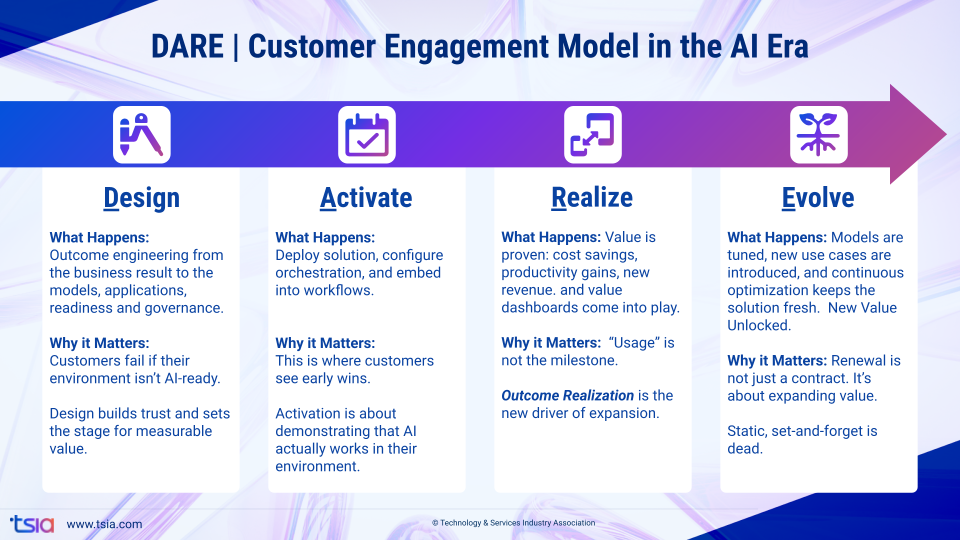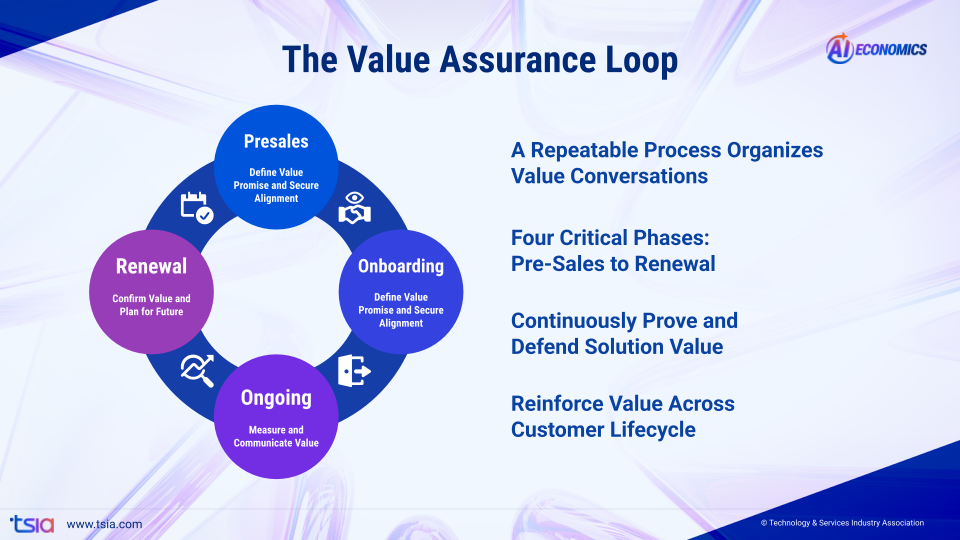AI Economics™ isn’t coming—it’s here. And it’s already gutting the biggest names in tech.
Here's the trap: Companies are slashing services teams to fund AI transformation. But AI doesn't reduce the need for services—it multiplies it exponentially. Every dollar cut from services today becomes ten dollars of unrealized AI value tomorrow.
But here's what most executives miss: AI shifts accountability from the customer to the vendor. In the old model, you sold software, and the customer did the work. In the AI model, the AI does the work, which means you own the outcome. Action, accountability, and results become your job. That job is services.
Serviceless AI is a myth. The Era of Tech Services is here. And the companies that win will be the ones that move now—before the market sets the anchors without them.
Key Takeaways
- AI is not eliminating services; it’s redefining them. AI introduces unprecedented complexity across infrastructure, integration, and application layers. That complexity must be designed, managed, and optimized. Services are the new multiplier of AI value, not a casualty of it.
- Incumbent business models are collapsing under AI Economics™. SaaS-era financial frameworks, focused on recurring revenue and feature adoption, can’t sustain AI-driven operations. Profitability in this new era depends on mastering outcome ownership, not license volume.
- The future belongs to service organizations that dare to rebuild. AI demands new delivery models, new metrics, and new operating structures. Leaders who embrace DARE—Design, Activate, Realize, Evolve—will dominate the next decade of technology services.
Incumbents at Risk: What Worked Yesterday Won’t Work Tomorrow
For decades, the tech industry’s giants have thrived by mastering one playbook after another. That playbook is now broken.
AI is forcing every incumbent to face a new economic reality: their existing business models, operating structures, and financial assumptions no longer hold.
What’s happening now mirrors the industry’s last significant disruption: when the SaaS revolution swallowed product-centric companies. Those who evolved survived—and those who didn’t, disappeared.
“If you thought swallowing the SaaS fish was hard, the AI fish is uglier, bonier, and full of teeth.” – George Humphrey, Senior VP of Research, TSIA.
Today, even the SaaS-born incumbents are in the same position their predecessors once faced. The move from product to service was hard. The move from SaaS to AI-first will be harder.
Why AI Is the Ultimate Disruptor
Most technology revolutions simplify complexity. AI multiplies it.
AI introduces what TSIA calls the AI Complexity Avalanche, a new set of interlocking challenges that redefine how technology is designed, integrated, and optimized.
- Infrastructure Layer: The base of AI operations, powered by GPUs, NPUs, and hyperscale computing. Companies must decide whether to build or buy, knowing that hardware becomes obsolete almost immediately.
Integration Layer: The connective tissue linking systems, data feeds, and services. This layer requires deep strategy, multi-vendor coordination, and constant re-architecture. - Application Layer: Where language models, agents, and verticalized AI products create differentiation but demand continuous tuning and oversight.
Each layer increases friction, cost, and risk.
In the SaaS era, automation reduced service requirements. In the AI era, automation drives demand for services. AI adoption is not plug-and-play; it’s design, governance, optimization, and outcome management. Every model must be trained, integrated, and measured. Every process must be rewritten.
AI doesn’t make technology easier to consume. It makes it exponentially harder.
“AI isn’t simplifying technology, it’s multiplying complexity. Services eat that complexity so the customer doesn’t have to.” – George Humphrey, Senior VP of Research, TSIA.
That’s the paradox of AI Economics™: the more intelligent the technology becomes, the more services it requires to stay healthy, secure, and aligned to business outcomes.
The Profitability Gap: Newcomers vs. Incumbents
AI Economics™ is exposing a widening divide between those built for AI and those still running SaaS-era economics.
TSIA tracks this transformation across three indices:
- TS50 – the world’s leading established technology and services companies.
- Cloud 40 – companies born in the SaaS and subscription economy.
- AI 20 – the newest generation of AI-first disruptors.
The AI 20 are growing at unprecedented rates—often above 100% annually—but they’re doing so with an average operating income of negative 30%. Profitability is sacrificed for velocity and consumed by complexity.
Incumbents, meanwhile, are stuck between eras. Their financial models, cost structures, and investor expectations were built for predictable SaaS growth, not the volatile economics of AI transformation.
They must evolve again, just as they did when SaaS upended perpetual licensing. The problem: the timeline is shorter, and the margin for error is smaller.
This is why so many leadership teams are struggling to make sense of the shift. They’re trapped in yesterday’s P&L while tomorrow’s competitors are rewriting the income statement.
In AI Economics™, profitability doesn’t come from selling software; it comes from owning outcomes.
The Services-Led Future of AI
The market narrative is wrong. AI will not eliminate services. It will supercharge them.
The AI era is not a threat to services—it’s their most significant opportunity in decades. The companies leading this transformation have already figured it out.
OpenAI: Betting Big on Professional Services
OpenAI isn’t just an AI product company. It’s a professional services powerhouse in disguise. With $2 billion in service-driven revenue today and a target of $30 billion by 2026, OpenAI is proving that AI value creation requires deep, embedded services.
Its delivery model doesn’t separate managed, support, or consulting functions. Everything falls under one umbrella: professional services. Every customer engagement is engineered around integration, customization, and continuous optimization.
Palantir: The Vanguard Model
Palantir built the Forward Deployed Engineer (FDE) model—a hybrid role combining the skills of a software engineer, consultant, and business strategist. FDEs don’t sell; they embed. They build, tune, and deliver outcomes measured directly in customer KPIs.
That model is producing measurable impact:
- $30M in savings at Trinity Rail through workflow automation in just 3 months.
- A 40–90% improvement in on-time delivery rates at Associated Materials.
- $14M in annual expense savings at General Mills.
- A 60% faster, 90% cheaper AML workflow overhaul for a global bank.
This is the new professional services model: high-impact, embedded, outcome-driven.

Databricks & Uplimit: Education Reinvented
In the education services industry, Databricks and partner Uplimit replaced instructor-led training with AI-driven enablement.
- 94% course completion rate.
- 75% reduction in live training time.
- 91% of learners apply new skills immediately.
AI tutors, real-time labs, and personalized learning paths now define education services in the AI era.

Palo Alto Networks: Dogfooding for Advantage
Palo Alto’s internal “Panda AI” handles nearly 60% of employee IT, HR, and finance support tickets autonomously, saving $3.5M in cloud costs and delivering 20–30% productivity gains across 6,000 engineers.
This closed-loop learning creates a self-reinforcing cycle—an internal flywheel called the Dogfooding Flywheel Advantage—where internal AI adoption strengthens commercial offerings.

ServiceNow: AI-Native Customer Success
ServiceNow Impact exemplifies AI-native customer success.
- 21% faster time to value.
- 24% increase in realized solution value.
- 10% rise in NPS.
- 12% productivity improvement.
Impact redefines customer success from reactive task management to data-driven value realization.

From LAER to DARE: The New Engagement Model
The customer engagement model that defined the SaaS era, LAER (Land, Adopt, Expand, Renew), is dead.
AI changes everything about how customers buy, use, and renew technology. The future model is DARE:
- Design: Engineer from the outcome backward. Start with business goals, data readiness, and governance.
- Activate: Deploy and embed AI to deliver visible impact.
- Realize: Prove the value. Measure productivity gains, cost savings, and new revenue streams.
- Evolve: Continuously tune models, introduce new use cases, and expand outcomes.
“DARE replaces LAER. Design, Activate, Realize, Evolve. Usage is dead. Value realization is the new renewal.” – George Humphrey, Senior VP of Research, TSIA.

DARE closes the Value Assurance Loop, a repeatable process that measures and demonstrates value across the entire lifecycle—from presales to renewal.

In the AI era, “usage” is irrelevant. Realized value is the only metric that matters. Renewal isn’t a contract date. It’s a proof point.
The New Rules of Value Engineering
AI Economics™ forces a new way of building and delivering technology. Services organizations must reorganize around value and outcome engineering—the functions that link what’s sold to what’s realized.
Three imperatives define this shift:
- Identify what AI will automate—and what it will amplify.
Every delivery organization must assess which services will be augmented by AI and which will be redefined entirely. This is not optional; CFOs expect the efficiency gains. - Establish a Value Engineering Function.
This becomes the anchor for defining, measuring, and defending value across all service lines. It connects offers, pricing, and performance directly to measurable outcomes. - Break and rebuild organizational silos.
The future of services is converged. Professional Services, Education, Support, Managed Services, and Customer Success cannot operate independently of one another.
Service PODs will form around products or verticals, staffed by cross-functional experts who design, activate, realize, and evolve outcomes. Supporting them: centralized Service Centers of Excellence providing analytics, automation, and engineering capabilities at scale.
This is not an incremental change. It’s organizational reconstruction.
The Irreversible Impact on Offers and Operations
By 2028, 80% of all enterprise technology spending will flow to AI-powered applications and robotics. The market will be split between two kinds of contenders:
- Well-funded AI natives born in the AI-first economy.
- Current leaders are fighting to retrofit their offers and operations for AI profitability.
Three new service categories are emerging as the foundation of this transformation:
- AI readiness and governance services: Preparing customers with the data, models, and organizational readiness required to succeed.
- Value optimization services: Continuously tuning performance, managing cost, and ensuring measurable ROI.
- Outcome-oriented AI services: Managing AI in production, including agentic workflow automation and outcome-based pricing.
These categories mark the next phase of services evolution—from labor-driven to intelligence-driven, from project-based to value-based.
This is the era of services convergence, where every offer is architected for outcomes, every function measures value, and every renewal is earned by proof, not promises.
Compete or Concede
The message for today’s technology leaders is simple: compete or concede.
AI Economics™ will not wait for your next budget cycle. The storm is here, and most organizations still have no basement to hide in.
Executives face a choice:
- Compete by embracing AI’s complexity, rebuilding their services architecture, and turning it into a differentiator.
- Or concede to a new generation of AI-native competitors already building faster, cheaper, and smarter.
The companies that win in AI Economics™ will not be those with the best models or the lowest costs. They’ll be the ones who can consistently design, activate, realize, and evolve customer outcomes.
This is not the end of services. This is the era of services, and it’s already underway.
FAQs
What does “AI Economics™” actually mean for technology services companies?
AI Economics™ represents the financial and operational shift created by AI adoption. It changes how companies generate revenue, deliver services, and achieve profitability. Traditional SaaS models measured usage; AI models measure outcomes.
Why is TSIA saying “AI will accelerate services” when the market believes AI automates them?
Automation increases technical complexity. Every AI system—models, data, governance, optimization—requires integration, monitoring, and continuous improvement. As complexity rises, service demand increases. AI doesn’t erase services; it expands them.
How should technology executives respond right now?
Executives must identify which services AI will automate and which it will amplify. They should establish a value engineering function, rebuild delivery around measurable outcomes, and align every team to the DARE framework. Waiting for clarity is not a strategy.
Smart Tip: Embrace Data-Driven Decision Making
Making smart, informed decisions is more crucial than ever. Leveraging TSIA’s in-depth insights and data-driven frameworks can help you navigate industry shifts confidently. Remember, in a world driven by artificial intelligence and digital transformation, the key to sustained success lies in making strategic decisions informed by reliable data, ensuring your role as a leader in your industry.





.png)

.png)




